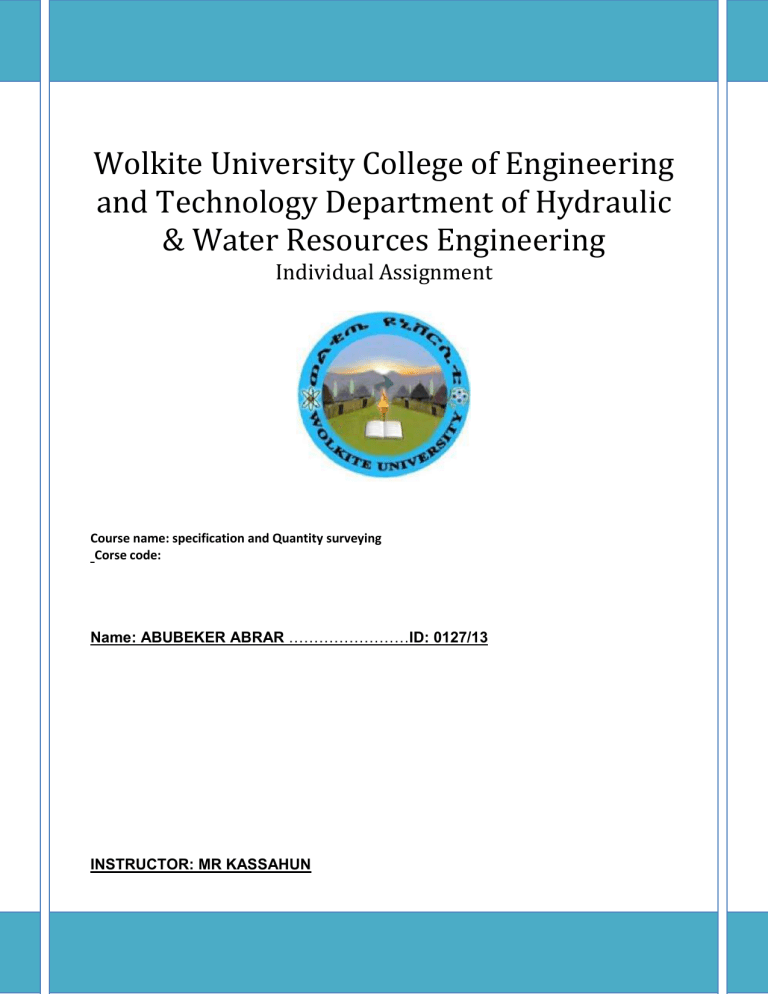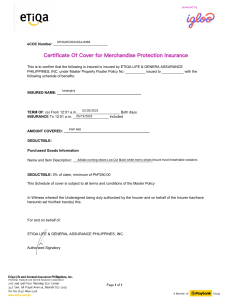
Wolkite University College of Engineering and Technology Department of Hydraulic & Water Resources Engineering Individual Assignment Course name: specification and Quantity surveying Corse code: Name: ABUBEKER ABRAR ……………………ID: 0127/13 INSTRUCTOR: MR KASSAHUN Wolkite University College of Engineering and Technology Department of Hydraulic & Water Resources Engineering Contents 1.Discuss in detail Special characteristics of insurance contracts and basic part of insurance policies? ..... 2 The Characteristics of Insurance Contracts ................................................................................. 2 Basic part of insurance policies.................................................................................................... 3 2. Explain the process of a project risk management step by step? ............................................................ 3 Process of a project risk management .................................................................................. 3 3. Discuss in detail all about contract type that are used in construction projects...................................... 4 Contract type that are used in construction projects .................................................................. 4 1 Wolkite University College of Engineering and Technology Department of Hydraulic & Water Resources Engineering 1. Discuss in detail Special characteristics of insurance contracts and basic part of insurance policies? The Characteristics of Insurance Contracts In today's uncertain world, individuals and organizations rely heavily on the security net provided by insurance policies to weather the inevitable storms of life. When insuring, the insurer guarantees the insured that, in exchange for a sum of money known as the 'premium,' he would protect them against damages brought on by a certain contingent occurrence by signing a contract. These contracts guarantee compensation in the event of certain losses. You must understand the nature and characteristics of an insurance contract to manage the complexity of insurance plans successfully. A contract is based on the highest standards of good faith, which require both parties to be completely forthright and honest with one another. Insurance contracts or agreements are based on the principle of indemnification, which seeks to put the insured back in the same financial situation before the insured event happened. Insurance contracts have some special characteristics that distinguish them from other types of contracts. Here are a few key characteristics: Utmost Good Faith: Insurance contracts are based on the principle of utmost good faith, which means that both the insurer and the insured must disclose all relevant information to each other honestly and accurately. This ensures that both parties have a clear understanding of the risks involved. Indemnity: Insurance policies are designed to provide indemnity, which means that they aim to restore the insured to the same financial position they were in before the occurrence of the insured event. Insurance is not meant to provide a profit for the insured but rather to mitigate financial losses. Insurable Interest: To have an insurance policy, the insured must have an insurable interest in the subject matter of the insurance. This means that the insured must have a financial interest or relationship with the insured property or person. Subrogation: If the insurer pays a claim to the insured, they may have the right to take legal action against any third party responsible for the loss or damage. This is known as subrogation, where the insurer steps into the insured's shoes to recover the amount paid. 2 Wolkite University College of Engineering and Technology Department of Hydraulic & Water Resources Engineering Basic part of insurance policies Insurance policies typically consist of the following sections Declarations: This section provides basic information about the insured, such as their name, address, policy period, and coverage limits. It also specifies the premium amount. Insuring Agreement: The insuring agreement outlines the scope of coverage provided by the insurance policy. It describes the risks covered, the events that trigger coverage, and any exclusions or limitations. Conditions: The conditions section sets out the rights and responsibilities of both the insured and the insurer. It includes information about premium payment, policy cancellation, claims procedures, and other important terms and conditions. Exclusions: This part lists the specific risks or situations that are not covered by the insurance policy. It's important to carefully review this section to understand what is excluded from coverage. Endorsements: Endorsements are additional provisions or modifications to the standard policy terms. They can be used to add or remove coverage, change policy limits, or make other adjustments based on the insured's specific needs. 2. Explain the process of a project risk management step by step? Process of a project risk management When you start the planning process for a project, one of the first things you need to think about is: what can go wrong? It sounds negative, but pragmatic project managers know this type of thinking is preventative. Issues will inevitably come up, and you need a mitigation strategy in place to know how to manage risks when project planning. Project risk management is the process of identifying, analyzing and responding to any risk that arises over the life cycle of a project to help the project remain on track and meet its goal. Risk management isn’t reactive only; it should be part of the planning process to figure out the risk that might happen in the project and how to control that risk if it in fact occurs. Step-by-step explanation of the project risk management process: Identify Risks: Start by identifying potential risks that could impact your project. This can be done through brainstorming sessions, reviewing historical project 3 Wolkite University College of Engineering and Technology Department of Hydraulic & Water Resources Engineering data, consulting subject matter experts, or using risk checklists. Document each identified risk in a risk register or similar document. Analyze Risks: Once risks are identified, analyze their potential impact and likelihood of occurrence. Assess the severity of each risk and prioritize them based on their significance to the project. This analysis helps in understanding which risks require more attention and resources. Plan Risk Response: Develop strategies to address the identified risks. This involves determining the most appropriate response for each risk, which can include avoiding, mitigating, transferring, or accepting the risk. Develop contingency plans and allocate necessary resources to implement these responses. Implement Risk Response: Put the planned risk response strategies into action. This may involve making changes to project plans, allocating additional resources, or implementing risk mitigation measures. Ensure that the risk response plans are communicated to the relevant stakeholders. Monitor and Control: Continuously monitor the project for any new risks that may arise or changes in the identified risks. Regularly assess the effectiveness of the implemented risk response plans and make adjustments as needed. This step also involves tracking and reporting on the status of risks and their associated responses. Learn from Experience: After the project is completed, conduct a post-project review to evaluate the effectiveness of the risk management process. Identify any lessons learned and document them for future projects. This step helps improve risk management practices for future endeavors. Remember, risk management is an ongoing process throughout the project lifecycle. It requires regular attention and adaptation to ensure that risks are effectively managed and project objectives are achieved. 3. Discuss in detail all about contract type that are used in construction projects Contract type that are used in construction projects In construction projects, several types of contracts are commonly used to define the relationship and obligations between the parties involved. Here are some of the most common contract types: 4 Wolkite University College of Engineering and Technology Department of Hydraulic & Water Resources Engineering Lump Sum or Fixed Price Contract: A lump sum or fixed price contract is an agreement where the contractor agrees to complete the project for a predetermined fixed price. This type of contract is suitable when the scope of work is well-defined, and there is minimal risk of changes or uncertainties. The advantage of a lump sum contract is that it provides the owner with a clear understanding of the project cost upfront. However, any changes or variations to the scope of work may require negotiation and additional costs. Cost plus Contract: In a cost plus contract, the owner agrees to reimburse the contractor for the actual cost of the project, plus a predetermined fee or percentage of the costs. This type of contract is often used when the project scope is uncertain or when the owner wants more control over the project. The advantage of a cost plus contract is that it allows for flexibility in accommodating changes during the construction process. However, it can also lead to increased costs and potential disputes over the accuracy of cost documentation. Time and Materials Contract: A time and materials contract involves paying the contractor for the actual time spent on the project and the materials used, plus an agreed-upon profit margin. This contract type is commonly used when the project scope is unclear, and the costs may vary significantly. It provides flexibility for the owner to make changes during construction, but it also requires careful monitoring of costs to ensure transparency and prevent cost overruns. Unit Price Contract: With a unit price contract, the contractor is paid based on the quantity of completed work, at a predetermined unit price. This type of contract is suitable when the project involves repetitive tasks or when the quantity of work can be accurately estimated. It provides transparency in pricing and allows for easy adjustment of costs based on the actual quantity of work performed. However, accurate quantity measurement is crucial to avoid disputes. Design-Build Contract: A design-build contract involves a single entity being responsible for both the design and construction of the project. This approach can streamline the process and reduce conflicts between different parties. The design-build contractor takes on the responsibility for delivering a complete project, including design, construction, and sometimes even maintenance. It can accelerate project delivery, but it requires clear communication and coordination between the design and construction teams. Joint Contracts Tribunal (JCT) Contracts: JCT contracts are widely used in the construction industry in the United Kingdom. They provide a standardized set of terms and conditions for various project types, ensuring clarity and consistency. JCT contracts cover areas such as project management, payment terms, 5 Wolkite University College of Engineering and Technology Department of Hydraulic & Water Resources Engineering variations, and dispute resolution. They are regularly updated to reflect industry best practices and legal requirements. FIDIC Contracts: The International Federation of Consulting Engineers (FIDIC) contracts are commonly used for international construction projects. FIDIC contracts provide a framework for the rights and obligations of the parties involved, addressing issues such as project management, quality control, and dispute resolution. They are recognized globally and offer a balanced approach to risk allocation between the owner and the contractor. Remember, the choice of contract type depends on factors such as project complexity, risk allocation, and the relationship between the parties involved. It is advisable to consult legal and industry professionals to determine the most suitable contract type for your specific construction project. 6



